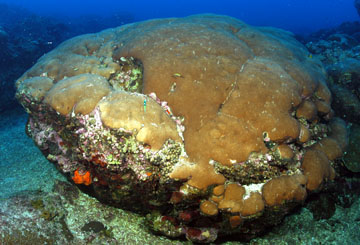Utilize our interactive and educational lesson plans and activities, like coloring pages and a word search, to educate students about coral reefs and the threats they face.

Students research an organism from coral reef ecosystems. Students will present their findings to the class, then create kinesthetic and visual ecosystem models, incorporating other organisms and nonliving things that are important for the ecosystem. Through their models and class discussion, students will demonstrate how biodiversity makes ecosystems more resilient.

This lesson focuses on species found in deep-sea coral communities and environmental factors that influence their presence and abundance. Students will view videos of real scientific transects taken with remotely operated vehicles (ROVs), and record data on the presence of specified species.

Students learn about the National Marine Sanctuary System by researching their habitats, species, physical features and cultural importance. Students will understand there is a tremendous diversity of ocean environments and life forms.

Students “visit” locations in Hawai’i and on the West Coast by exploring a model of the Pacific basin, analyzing close-up photos of sand at various beaches in national marine sanctuaries and monuments. Students speculate about the origins of sand and geological processes that create it. They realize that many constructive and destructive forces are at work between land and sea.

Coral reefs are one of the most diverse ecosystems on the planet. In this module, students will use real data to investigate the consequences of rising sea surface temperature on coral reefs. They will also consider the importance of coral reefs in their own lives.

Students will research the ecology of coral reefs, natural and anthropogenic threats to corals, and the science of coral restoration. In pairs, students will design and make an argument for a proposed new coral nursery to be placed within Florida Keys National Marine Sanctuary (FKNMS).

This activity compares coral growth with building construction to help students understand the benefits of different coral shapes for survival.

An activity book that features the importance of coral reefs to the Hawai’i marine environment through coloring, a word search, a matching game, and more.

This lesson focuses on understanding the impacts of ocean acidification on the olfactory senses of clownfish. Students will be able to define ocean acidification and understand how specific species such as the clownfish may be affected by the increasing acidity of the ocean.

This tutorial is an overview of the biology of and threats to coral reefs, as well as efforts being made to conserve and protect them. It includes images and animations. The Roadmap to Resources complements the tutorial. It directs you to specific online coral data and information from NOAA.

Explore this resource of a labeled coral polyp diagram to learn more about the anatomy of corals.

Here is a coloring page resource that demonstrates the asexual reprodution of coral polyps.

Jump into the waters of the Flower Garden Banks National Marine Sanctuary through this virtual diving experience!

This activity will introduce students to the multi-faceted biology of reef-building corals--animals that are also part plant and part mineral. Students will turn their own hands into coral polyp models and learn about the special symbiotic relationship that enables corals to survive.

This activity will introduce students to the methods used for evaluating underwater habitats and the kinds of information that can be learned from those efforts.

These are some of the coloring pages from the Papahānaumokuākea National Marine Monument that explain the reef environment at different times of day, how reefs are formed, and more.

This coloring page represents the biodiverse coral reef systems found in the Flower Garden Banks National Marine Sanctuary.

In this lesson, students will learn about different types of animals that inhabit a coral reef environment, then work cooperatively to construct a mural that depicts a coral reef scene.

This crossword puzzle will help students learn about coral ecosystems in the Flower Garden Banks National Marine Sanctuary in an engaging way!

In this lesson students will explore the effects of acidic oceans on certain marine organisms, in the ocean food web, and to humans. Students will conduct a science experiment using the scientific method to see the effects of increased acidity on certain species.

This reef word search features important marine related vocabulary words for students to learn in this entertaining activity.

This activity models the appearance of the mass coral spawning event that takes place at Flower Garden Banks National Marine Sanctuary every August. The result is like a snow globe in which the “snow” floats up instead of down, and the scene is a model of a coral reef.

The Coral Check-up Lesson Series introduces students to coral reef monitoring and ecology through virtual real world experiences focused in the Hawaiian archipelago. Students use NOAA and NOAA partner data and resources to assess coral bleaching impacts, immersing themselves in a worldwide effort to protect and conserve coral reefs.

Most people are familiar with the growth rings seen in tree cross sections, but few are aware that similar growth patterns are visible in skeletons of reef-building corals. This activity will introduce students to these growth patterns and what they can tell us about the environment in which the corals live.

Engage students through this engaging word search activity to learn more about coral reef ecosystems.

Education resources are distributed across many websites and program offices at NOAA and partner websites. This portal is designed to help you access these resources from one location. Materials are organized by themes aligned with common teaching topics. Explore the larger NOAA resource collection on coral reef ecosystems.